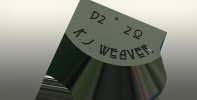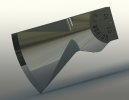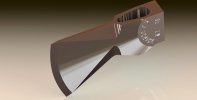As Phantomknives pointed out, research balancing and desired design before you commit to your tempering. The shape and balance can definitely drastically effect the axe's performance depending on it's use.
I have a few laying around but the best chopper I have is an old Hults Bruk axe which seems to out perform the others. Between the middle of the eye and the middle of the bit, the steel is fairly thick still has a feint slope, but near the top and bottom contours between eye and bit it tapers thinner, I believe to alleviate the axe-sticking-in-tree problem while retaining a fair bit of mass to still deliver a solid swing.
I am no professional, most of what I do it out of the vehicle repair shop area of our moving&storage warehouse in my spare time so forging is not a full time hobby or career (yet!). A full heat & slow cool followed by tempering the bit to near tool hardness (yellow/gold - same for chisels by my understanding, holds an edge but less prone to chipping than going around blue) would be ideal for chopping, however you said this steel is already specially heat treated so this is more "at your discretion", plus I'm not familiar with the particular steel enough to know how it'll react to heat treating so as always, research would be wise. Fairly resilient steel on its own, the light temper & oil quench on the edge/bit should add some retention after you have your bevel set. Just remember to heat slow due to the (presumed) thickness of the steel and only get the first inch or two if possible as it's mostly the edge you want the form retention, you don't want to make the eye brittle. The eye and butt end should be as soft as hammer steel, again, to handle years of potential abuse without cracking or shattering.
Pictures/dimensional info would be needed for proper input but as a first go with a tool that by inherent design is meant for some abuse, I would say give it a drop-in handle (thinner hand-hold, axe head slips down to the mallet-like end where it pressure-fits (easy to disassemble and no worry of it flying off as long as it is good and snug after a few vertical drops (it's how I've been testing edges on axes I've refitted & sharpened for friends over the years))) and a couple swings at a log, that would probably be your best test prior to a properly fitted & set handle. Some lessons are best learned through trial & error, plus it gives you an idea for what the steel you're using can tolerate. Goodluck!



